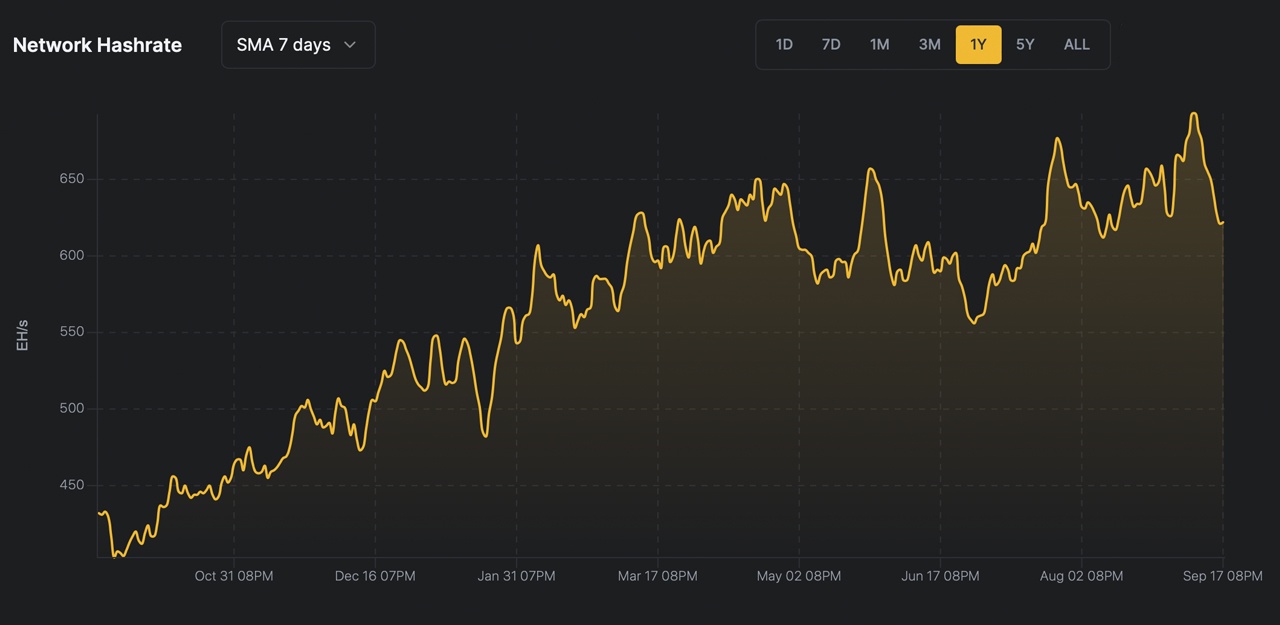Recent metrics reveal that after Bitcoin’s network hashrate reached an all-time high of 693 exahash per second (EH/s) and saw a 3.58% difficulty increase, its computational power decreased this week. In the nine days since this peak, the hashrate has fallen by 9.95%.
Bitcoin Miners Confront Economic Hurdles as Bitcoin Hashrate Dips
Bitcoin miners are still under significant pressure as revenue is not what it used to be in the mining industry. Since the fourth Bitcoin reward halving, the subsidy dropped from 6.25 BTC to 3.125 BTC per block. In addition to the reward subsidy, miners also get fees from all the transactions processed, but onchain fees have been considerably low at rates not seen since 2022.

Mempool.space indicates that a high priority fee is 3 satoshis per virtual byte (sat/vB) which equates to $0.25. Moreover, BTC’s price has been lower in recent times leading to the hashprice, or the overall value of 1 petahash per second (PH/s) per day, to slide considerably.
On top of all that, the network recorded a 3.58% difficulty increase reaching a new peak in difficulty on Sept. 10, two days after the hashrate high. The lifetime computational power high was on Sept. 8, when the network reached 693 EH/s. The combination of the aforementioned elements has caused a 9.95% slide in hashpower.
So far, 69 EH/s has been erased since the peak nine days ago sliding to the current low of 624 EH/s. The decline in Bitcoin’s hashpower highlights the mounting challenges miners encounter with diminishing rewards combined with low transaction fees. As profitability wanes, only the most efficient operations are likely to persist, potentially concentrating mining power.
What do you think about Bitcoin’s hashrate sliding 69 EH/s? Share your thoughts and opinions about this subject in the comments section below.
Recent metrics reveal that after Bitcoin’s network hashrate reached an all-time high of 693 exahash per second (EH/s) and saw a 3.58% difficulty increase, its computational power decreased this week. In the nine days since this peak, the hashrate has fallen by 9.95%.
Bitcoin Miners Confront Economic Hurdles as Bitcoin Hashrate Dips
Bitcoin miners are still under significant pressure as revenue is not what it used to be in the mining industry. Since the fourth Bitcoin reward halving, the subsidy dropped from 6.25 BTC to 3.125 BTC per block. In addition to the reward subsidy, miners also get fees from all the transactions processed, but onchain fees have been considerably low at rates not seen since 2022.

Mempool.space indicates that a high priority fee is 3 satoshis per virtual byte (sat/vB) which equates to $0.25. Moreover, BTC’s price has been lower in recent times leading to the hashprice, or the overall value of 1 petahash per second (PH/s) per day, to slide considerably.
On top of all that, the network recorded a 3.58% difficulty increase reaching a new peak in difficulty on Sept. 10, two days after the hashrate high. The lifetime computational power high was on Sept. 8, when the network reached 693 EH/s. The combination of the aforementioned elements has caused a 9.95% slide in hashpower.
So far, 69 EH/s has been erased since the peak nine days ago sliding to the current low of 624 EH/s. The decline in Bitcoin’s hashpower highlights the mounting challenges miners encounter with diminishing rewards combined with low transaction fees. As profitability wanes, only the most efficient operations are likely to persist, potentially concentrating mining power.
What do you think about Bitcoin’s hashrate sliding 69 EH/s? Share your thoughts and opinions about this subject in the comments section below.





